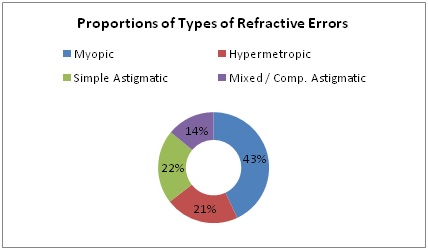A cross sectional study of epidemiology corresponding to refractive errors in school going children in urban areas of Hyderabad
Abstract
Introduction: There are estimated to be 1.4 million children in the world, 75% of whom live in low-income countries. Approximately, 80% of blindness is avoidable. The prevalence of the childhood blindness is estimated from 0.3 per 1000 children in the wealthy region of the world to 1.5 per 1000 children in the poorer countries/regions.
Methodology: The study was conducted From January to June 2018, in Princess Esra Hospital, a 1000 bedded teaching hospital, situated in Hyderabad, providing specialized tertiary level health care services to all strata of people. Children studying in the high school in Government and Private school were selected for the present study, the children selected has a history of overall good health.
Aims and Objectives: This planned study has been attempted with the accompanying targets, to concentrate on the predominance of refractive errors in school going children and to assess the etiologic proof.
Results: The total of 540 children were included in the study with the history of overall good health, which includes 82 females and 25 males diagnosed with refractive errors, shows that prevalence of refractive errors are more in female than compare to males.
Conclusion: In this study, it has been recorded that 19.8% of the screened school children have refractive errors. The results showed significant statistical difference regarding the prevalence of refractive errors between children of government and private schools.
Downloads
References
2. Resnikoff S, Pascolini D, Mariotti SP, Global magnitude of visual impairment caused by uncorrected refractive errors in 2004. Bull World Health Organ. 2008 Jan;86(1):63-70.[pubmed]
3. Gilbert C, Foster A. Blindness in children: control priorities and research opportunities. Br J Ophthalmol. 2001 Sep;85(9):1025-7.[pubmed]
4. Thylefors B. A global initiative for the elimination of avoidable blindness. Community Eye Health. 1998;11(25):1-3.[pubmed]
5. World Health Organization, Elimination of avoidable visual disability due to refractive error Report of an informal planning meeting WHO/PBL/00.79 pp: 6-10.
6. World Health Organization, Geneva. Preventing blindness in Children: Report of a WHO/IAPB Scientific meeting, Hyderabad, India; 13-17 April, 1999; 13-14 (WHO_PBL_00.77).
7. World Health Organization, The State of the World‘s Sight, 2005. VISION 2020: The Right to Sight. 1995-2005.
8. Gilbert, C; Foster, A (2001) Childhood blindness in the context of VISION 2020 - The Right to Sight. Bulletin of the World Health Organization, 79 (3). pp. 227-32. ISSN 0042-9686
9. Gilbert CE, Anderton L, Dandona L, et al. Prevalence of visual impairment in children: a review of available data. Ophthalmic Epidemiol. 1999 Mar;6(1):73-82.[pubmed]
10. Childhood cataract: magnitude, management, economics and impact. Shamanna BR, Muralikrishnan R eds. Community Eye Health. 2004;17(50):17-8.
11. World Health Organization. Programme for the Prevention of Blindness and Deafness. (2000). Global initiative for the elimination of avoidable blindness. Geneva : World Health Organization. http://www.who.int/iris/handle/10665/63748
12. Padhye S A et al. Prevalence of uncorrected refractive error and other eye problems among urban and rural school children. Middle East African Journal of ophthalmology. 2009; 16(2) 69-74.
13. Foster A, Gilbert C, Johnson G. Changing patterns in global blindness: 1988-2008. Community Eye Health. 2008 Sep;21(67):37-9.[pubmed]
14. Gilbert C, Muhit M. Twenty years of childhood blindness: what have we learnt?, Community Eye Health Journal 20th Anniversary edition. 2008; 21(67): 46-47.
15. Seet B, Wong TY, Tan DT, et al. Myopia in Singapore: taking a public health approach. Br J Ophthalmol. 2001 May;85(5):521-6.[pubmed]
16. Bhatt, Janardhanl, Trivedi, Vevik, Sundeep, Prevalence of refractive error in children (age pp 7-15 years) of rural & urban area of Gujarath; A population based study. Journal of Applied basic medical sciences, 2006,8(1);128-135.
17. Magnitude of refractive errors among school children in a rural block of Haryana. Sharma Seema, B.M. Vashist, Dept. of Community Medicine, PGIMS. International Journal of Epidemiology 2009;Vol.6, Pg 1-5. DOI: 10.5580/1e5f
18. Sethi s, Kartha G. P, prevalence of refractive errors in school children of Ahamedabad city. Ind J conn med 2000;25(4);181-183

Copyright (c) 2018 Author (s). Published by Siddharth Health Research and Social Welfare Society

This work is licensed under a Creative Commons Attribution 4.0 International License.


 OAI - Open Archives Initiative
OAI - Open Archives Initiative


